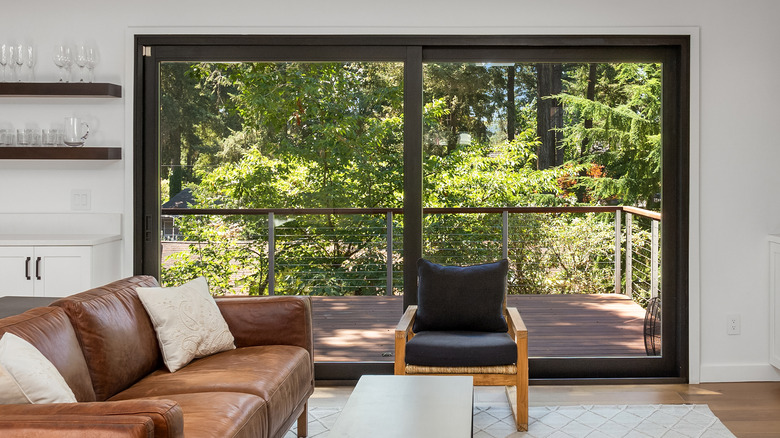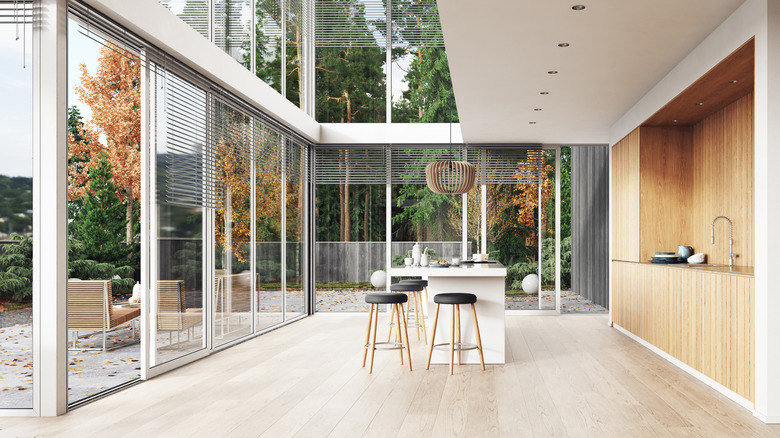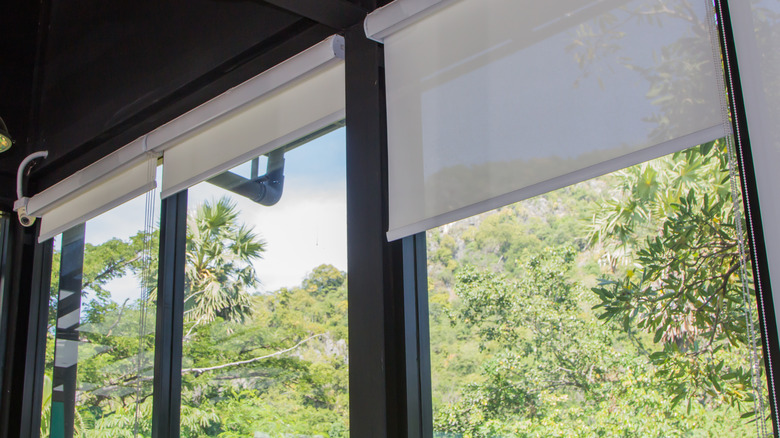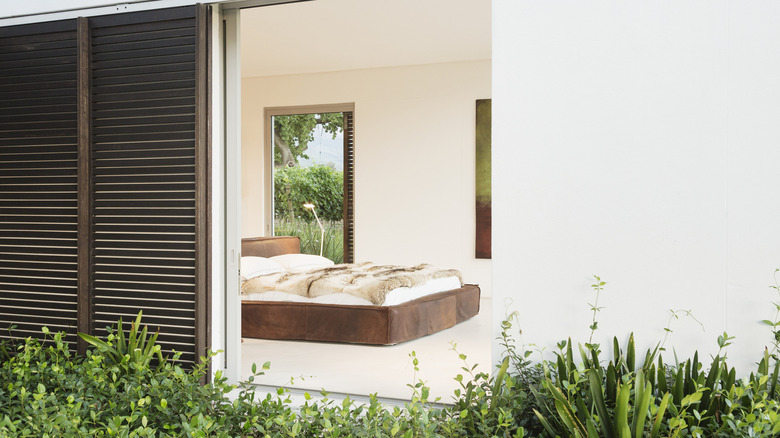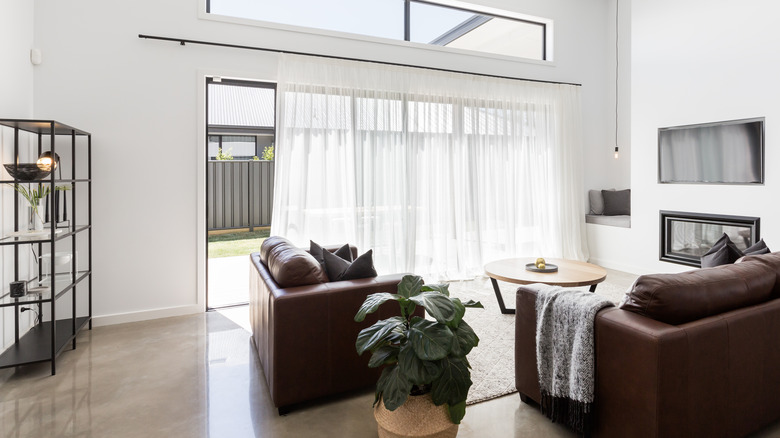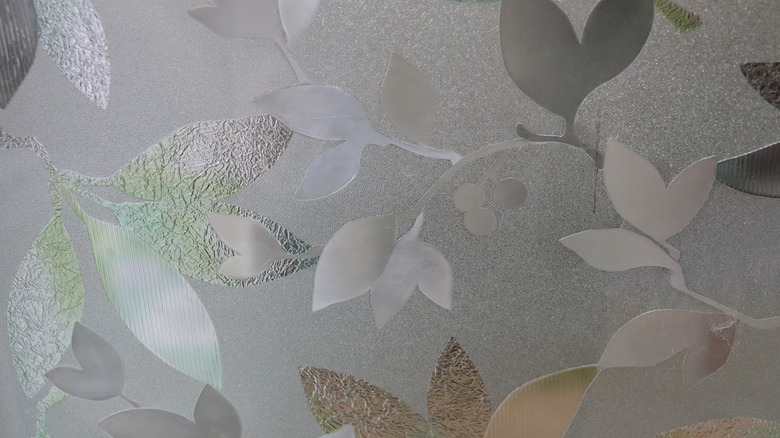How To Add Style To Sliding Glass Door Coverings
Sliding glass doors are a coveted home design feature. Dako says they not only add resale value to your home but that, as far as home additions and upgrades go, they have one of the highest returns. Not only are they a sound financial choice, but they are also durable, add window area while still functioning as a door, tend to be energy efficient, and help save space when compared to a traditional door.
Sliding glass doors also provide lots of natural light. That isn't a good thing for everyone, though. Whether you live somewhere with scorching midday sun rays, prefer darker environments, or have privacy concerns, you should also consider investing in coverings for your sliding glass doors. Most doors will come with optional sliding blinds, but those can look quite basic and don't mesh well with every home décor aesthetic. Luckily, there are multiple trendy, stylish ways to cover your sliding glass doors.
Built-in blinds
Traditional blinds, whether vertical or horizontal, are very effective at what they aim to do, both blocking light and letting it filter through. However, they tend to snag, get dirty, get in the way, and more. They also don't always look that nice, adding a clunky, plastic texture to an otherwise sleek pane of glass.
This is where built-in blinds come into play. Built-in blinds are just that — blinds built inside the pane, per American Thermal Window. A slider usually operates the blinds on the side of the door or window, which magnetically pulls the latter up and down, open and closed. Some come with a remote control to automate this task. Built-in blinds provide the option to either let light in or block it as the traditional variety, but they don't get dirty and are much less likely to tear or get stained. They are a pricy installation, though, requiring you to purchase brand new doors that start at $1,000, via The Home Depot.
Roller shades
Another great and more attractive alternative to basic blinds is roller shades. Roller shades are, as the name suggests, window shades that roll at the top of the window, and you simply pull them down to lower and lift them to gather them at the top. As Blinds points out, these shades are incredibly versatile and stylish. They're offered in a variety of opaqueness, with some shades letting light filter through and others being completely blackout. You can also choose between multiple fabrics, textures, colors, etc.
Some roller shades have traditional cords to open and close, but they often require you to pull them up and down, making them much safer. Since these are installed onto existing sliding glass doors, as opposed to replacing them entirely, it's also more cost-efficient. The price varies depending on the quality, fabric, opaqueness, and size. Still, an average roller shade for a 60-inch wide, 84-inch long sliding glass door, roughly the smallest average, per Fab Glass and Mirror, starts around $190, via Wayfair.
Sliding shutters
Another stylish way to cover your sliding glass doors is with sliding shutters. This option offers a distinct appearance and is ideal for a farmhouse, ranch, or other more rustic home décor styles. Those with a more modern or streamlined look can still partake, but you may need to look for custom-made shutters to fit more appropriately with your aesthetic.
Sliding shutters are usually mounted on a track and can slide close to offer shade and privacy or open to let in light. As Direct Buy Blinds points out, this type of sliding glass door treatment has plenty of advantages. They don't tear or snag like traditional blinds, are very easy to clean, and don't sway or bang against the door. There are also folding shutters, which let you access more of your sliding doors when open but also take up more space. This is a pricier and more permanent installation, though. Wood shutters can range from $200 to $350, but cheaper materials can range from $70 to $260; don't forget about labor costs, via De Kooktips.
Curtains
Covering your sliding glass doors doesn't need to be an expensive project or permanent installation. Most sliding glass doors already somewhat function like a window, so why not treat them as such and add some curtains? Curtains are safer and more stylish than blinds, as well as customizable. If you prefer a darker environment, you can opt for blackout curtains, but those wanting a more breezy, beach house effect can go for sheer panels.
Aside from style, there are a few other practical factors to consider. For instance, since you'll be drawing the curtains so often, you should make sure they're easily operable. This is why Kwik-Hang recommends pinch pleat or grommet curtains instead of pocket curtains. Similarly, installing a tie back, or simply getting a curtain holdback cord, is an excellent idea to keep them out of the way when using your sliding glass door. Finally, make sure to measure accurately, allowing space for clearance and enough material to cover the door without drowning it in fabric.
Window film
Window film is a great and cost-efficient way to cover your sliding glass doors. The most popular window film is tinted, but there are a variety of styles that can match any home décor approach. For a feminine style, you can choose a delicate floral pattern, like this one from Window Film World. Those with more eccentric tastes may prefer a more dramatic stained glass film, and those with simpler tastes may just want the frosted glass variety. While most films provide some level of seclusion, some are explicitly designed to provide privacy, and other films reduce glare, prevent UV light penetration, etc., via Lowe's.
While most window films are inexpensive, the hassle with this method is its application. Begin by cleaning your sliding glass door thoroughly, then cut the cling film, adding about an inch extra to the door's dimensions. Very carefully apply the film, working from the top edge to the bottom, and being careful to remove any air bubbles as you go. Then, trim away the excess film, and secure the corners.
